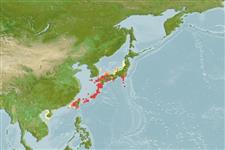Common names from other countries
>
Gobiiformes (Gobies) >
Gobiidae (Gobies) > Gobiinae
Etymology: Eviota: No etymology given, suggested by Christopher Scharpt: from Latin 'eu' for 'true' and 'iota' for anything very small, in combination 'truly very small' referring to it as being the smallest vertebrate at the time it has benn described by Jenkins (thus, making the suggestion by Scharpt plausible.; specca: Name based on the Anglo/Saxon 'specca' for speckled, referring to the heavy speckling of chromatophores over the body; noun in apposition.
Environment: milieu / climate zone / depth range / distribution range
Ecologia
marinhas; intervalo de profundidade 5 - 14 m (Ref. 95167). Subtropical
Northwest Pacific: Japan, Ryukyu Is..
Tamanho / Peso / Idade
Maturity: Lm ? range ? - ? cm
Max length : 1.2 cm SL macho/indeterminado; (Ref. 95167)
Descrição breve
Chaves de identificação | Morfologia | Morfometria
Espinhos dorsais (total) : 7; Raios dorsais moles (total) : 8; Espinhos anais: 1; Raios anais moles: 8; Vértebras: 26. This species is distinguished from its congeners by the following set of characters: cephalic sensory pore system pattern 1 (complete); 8/8 dorsal/anal-fin formula; body heavily sprinkled with chromatophores; upper pectoral-fin base pigmented; 4 subcutaneous body bars between anal-fin origin and caudal-fin base; occipital spot absent; pale opercular membrane; first dorsal fin sprinkled with small melanophores and chromatophores; caudal peduncle with no distinct dark spot or bar; cheek crossed by dark lines, red spots absent (Ref. 95167).
Life cycle and mating behavior
Maturities | Reprodução | Spawnings | Egg(s) | Fecundities | Larvas
Greenfield, D.W., T. Suzuki and K. Shibukawa, 2014. Two new dwarfgobies of the genus Eviota from the Ryukyu Islands, Japan (Teleostei: Gobiidae). Zootaxa 3774(5):481-488. (Ref. 95167)
Categoria na Lista Vermelha da IUCN (Ref. 130435)
CITES (Ref. 128078)
Not Evaluated
Ameaça para o homem
Harmless
Utilização humana
Ferramentas
Relatórios especiais
Descarregue XML
Fontes da internet
Estimates based on models
Preferred temperature (Ref.
115969): 20.5 - 26.3, mean 23.3 (based on 102 cells).
Phylogenetic diversity index (Ref.
82804): PD
50 = 0.5000 [Uniqueness, from 0.5 = low to 2.0 = high].
Bayesian length-weight: a=0.00708 (0.00333 - 0.01504), b=3.09 (2.92 - 3.26), in cm Total Length, based on LWR estimates for this (Sub)family-body shape (Ref.
93245).
Nível Trófico (Ref.
69278): 2.9 ±0.3 se; based on size and trophs of closest relatives
Resiliência (Ref.
120179): Elevada, tempo mínimo de duplicação da população menor que 15 meses (Preliminary K or Fecundity.).
Fishing Vulnerability (Ref.
59153): Low vulnerability (10 of 100).
